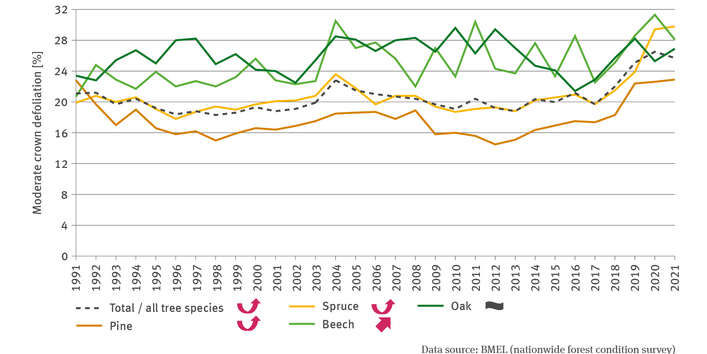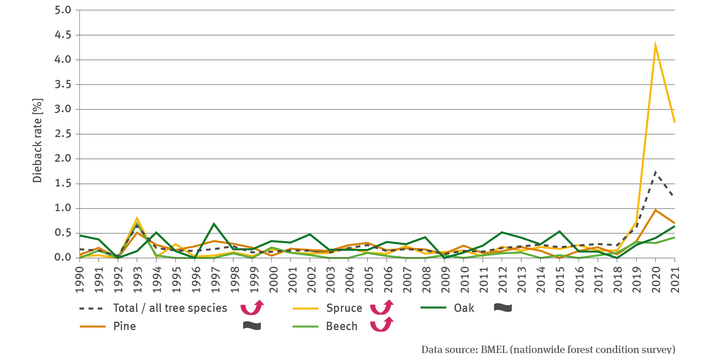For many years, the condition of crowns was considered a suitable indicator for illustrating the impacts of pollutants on the vitality of forest trees. Nowadays the focus of interpreting data on forest condition has shifted to weather patterns and infestation with pests. The connections between the temporal progress of needle or leaf loss and summer heat or drought have become evident. The following points should be taken into account when interpreting data regarding the condition of tree crowns: However, trees losing their leaves or ‘needles’ does not necessarily mean that they are damaged. In the case of deciduous trees, the spontaneous shedding of leaf mass under unfavourable conditions is frequently an appropriate adaptation response. This response helps trees to take precautions against losing too much water. The situation becomes only critical when an accumulation of drought-stress years causes crown defoliation to become a permanent feature in the affected trees. This kind of development is bound to lead to vitality losses or even to trees dying. However, the situation is slightly different in respect of coniferous trees, because they respond less spontaneously to needle loss owing to their greater investment into making permanent leaves (‘needles’). In these cases it seems more reasonable to assume that crown defoliation suggests some kind of damage affecting the trees. The connections with fruiting should also be taken into account, as this too, has a major influence on crown condition. In so-called mast years with particularly heavy fruiting, trees reduce their investment in leaf and needle mass. In those circumstances, a tree’s crown appears more transparent. 2016, for instance, stood out as a year of an abundant production of beechnuts – a mast year. So far, there is only scant information available on fruiting regularities. This issue, too, is seen as connected with climate change. For example, in former times beech and oak trees would have had mast years approximately every six or seven years, whereas these days the frequency is every two or three years.
Up until 2017 there had been no indications that the condition of forests was deteriorating continuously owing to climate-related changes. This has changed since the time of the heat and drought years of 2018 to 2020. Apart from oak trees, all main tree species nowadays indicate significantly rising trends in terms of deteriorating condition. As early as 2019 – the first year that succeeded the drought year of 2018 – the forest condition in respect of beech, spruce and pine trees was worse than after 2003, the ‘summer of the century’. As far as oak trees are concerned, there has been less evidence of crown defoliation caused by impacts of weather patterns. This species is therefore considered to be the tree of the future in climate-resilient forests.
The impacts caused by heat and drought are reflected even more conspicuously in the dieback rate than the crown defoliation mean. Trees are considered dead once they no longer have any living ‘needles’ or leaves or conductive tissue in the trunk but are still upright in the stand, thus being included in the trees sampled as part of a forest condition survey. First, recumbent trees and any trees removed from the forest (cf. Indicator FW-I-5) are substituted by sample trees. The annual dieback rate is typically not influenced by individual damaging events in the short term. Instead, problems can emerge years later as consequential damage at a much higher dieback rate, when damaged trees are no longer able to compensate for high leaf und needle losses or when – owing to their weakened state – these trees fall prey to pest organisms. However, as a result of recent drought years, the incidents of damage were so enormous that already in 2020, the subsequent year, the dieback rate skyrocketed. As far as spruce trees are concerned, the mean of the preceding 10 years (2010–2019) had increased 20-fold. Dieback affected spruce trees – and to a lesser extent – also pine trees and this entailed not just individual trees but entire forest stands dying. Beech and oak were also affected by the consequences of increased dieback rates, although in these cases, it was predominantly individual trees and smallish stands of trees which died.
Wide areas of dead stands present reforestation with particularly demanding challenges. For natural regeneration of forests to occur, there is often a lack of suitable seed trees for future-resilient tree species in the local environment or the potential for natural regeneration is low. Natural regeneration by means of active planting or seeding can be inhibited by large quantities of calamity timber. Moreover, without the shading or sheltering effect of mature trees, potential regeneration areas are unprotected from wind or irradiation from the sun; this makes it harder for trees to grow whilst favouring the development of high grass and regeneration damage by mice.

